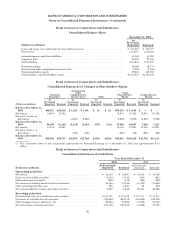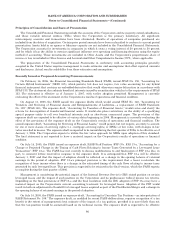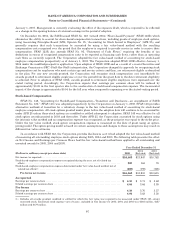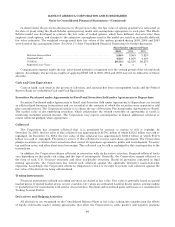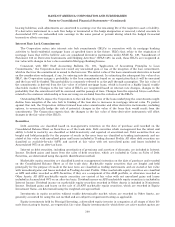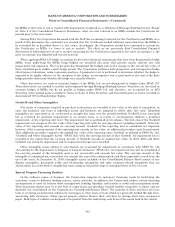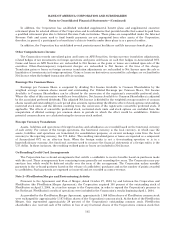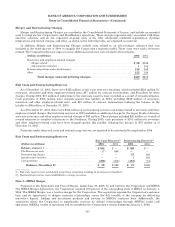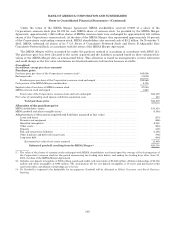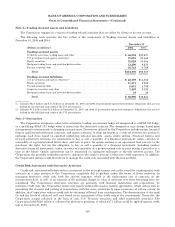Bank of America 2005 Annual Report Download - page 140
Download and view the complete annual report
Please find page 140 of the 2005 Bank of America annual report below. You can navigate through the pages in the report by either clicking on the pages listed below, or by using the keyword search tool below to find specific information within the annual report.BANK OF AMERICA CORPORATION AND SUBSIDIARIES
Notes to Consolidated Financial Statements—(Continued)
Securitizations
The Corporation securitizes, sells and services interests in residential mortgage loans, and from time to time,
consumer finance, commercial and credit card loans. The accounting for these activities are governed by SFAS 140. The
securitization vehicles are Qualified Special Purpose Entities (QSPEs) which, in accordance with SFAS 140, are legally
isolated, bankruptcy remote and beyond the control of the seller. QSPEs are not included in the consolidated financial
statements of the seller. When the Corporation securitizes assets, it may retain interest-only strips, one or more
subordinated tranches and, in some cases, a cash reserve account which are generally considered residual interests in
the securitized assets. The Corporation may also retain senior tranches in these securitizations. Gains and losses upon
sale of the assets depend, in part, on the Corporation’s allocation of the previous carrying amount of the assets to the
retained interests. Previous carrying amounts are allocated in proportion to the relative fair values of the assets sold and
interests retained.
Quoted market prices are used to obtain fair values of senior retained interests. Generally, quoted market prices for
retained residual interests are not available; therefore, the Corporation estimates fair values based upon the present
value of the associated expected future cash flows. This may require management to estimate credit losses, prepayment
speeds, forward yield curves, discount rates and other factors that impact the value of retained interests. See Note 9 of
the Consolidated Financial Statements for further discussion.
The excess cash flows expected to be received over the amortized cost of the retained interest is recognized as
Interest Income using the effective yield method. If the fair value of the retained interest has declined below its carrying
amount and there has been an adverse change in estimated contractual cash flows of the underlying assets, then such
decline is determined to be other-than-temporary and the retained interest is written down to fair value with a
corresponding adjustment to earnings.
Other Special Purpose Financing Entities
Other special purpose financing entities are generally funded with short-term commercial paper. These financing
entities are usually contractually limited to a narrow range of activities that facilitate the transfer of or access to various
types of assets or financial instruments and provide the investors in the transaction protection from creditors of the
Corporation in the event of bankruptcy or receivership of the Corporation. In certain situations, the Corporation
provides liquidity commitments and/or loss protection agreements.
The Corporation determines whether these entities should be consolidated by evaluating the degree to which it
maintains control over the financing entity and will receive the risks and rewards of the assets in the financing entity. In
making this determination, the Corporation considers whether the entity is a QSPE, which is generally not required to
be consolidated by the seller or investors in the entity. For non-QSPE structures or VIEs, the Corporation assesses
whether it is the primary beneficiary of the entity. In accordance with FASB Interpretation No. 46 (Revised December
2003), “Consolidation of Variable Interest Entities, an interpretation of ARB No. 51” (FIN 46R), the primary beneficiary
is the party that consolidates a VIE based on its assessment that it will absorb a majority of the expected losses or
expected residual returns of the entity, or both. For additional information on other special purpose financing entities,
see Note 9 of the Consolidated Financial Statements.
Income Taxes
The Corporation accounts for income taxes in accordance with SFAS No. 109, “Accounting for Income Taxes” (SFAS
109), resulting in two components of Income Tax Expense: current and deferred. Current income tax expense
approximates taxes to be paid or refunded for the current period. Deferred income tax expense results from changes in
deferred tax assets and liabilities between periods. These gross deferred tax assets and liabilities represent decreases or
increases in taxes expected to be paid in the future because of future reversals of temporary differences in the bases of
assets and liabilities as measured by tax laws and their bases as reported in the financial statements.
Deferred tax assets have also been recognized for net operating loss carryforwards and tax credit carryforwards.
Valuation allowances are then recorded to reduce deferred tax assets to the amounts management concludes are more
likely than not to be realized.
Retirement Benefits
The Corporation has established qualified retirement plans covering substantially all full-time and certain part-time
employees. Pension expense under these plans is charged to current operations and consists of several components of net
pension cost based on various actuarial assumptions regarding future experience under the plans.
104



